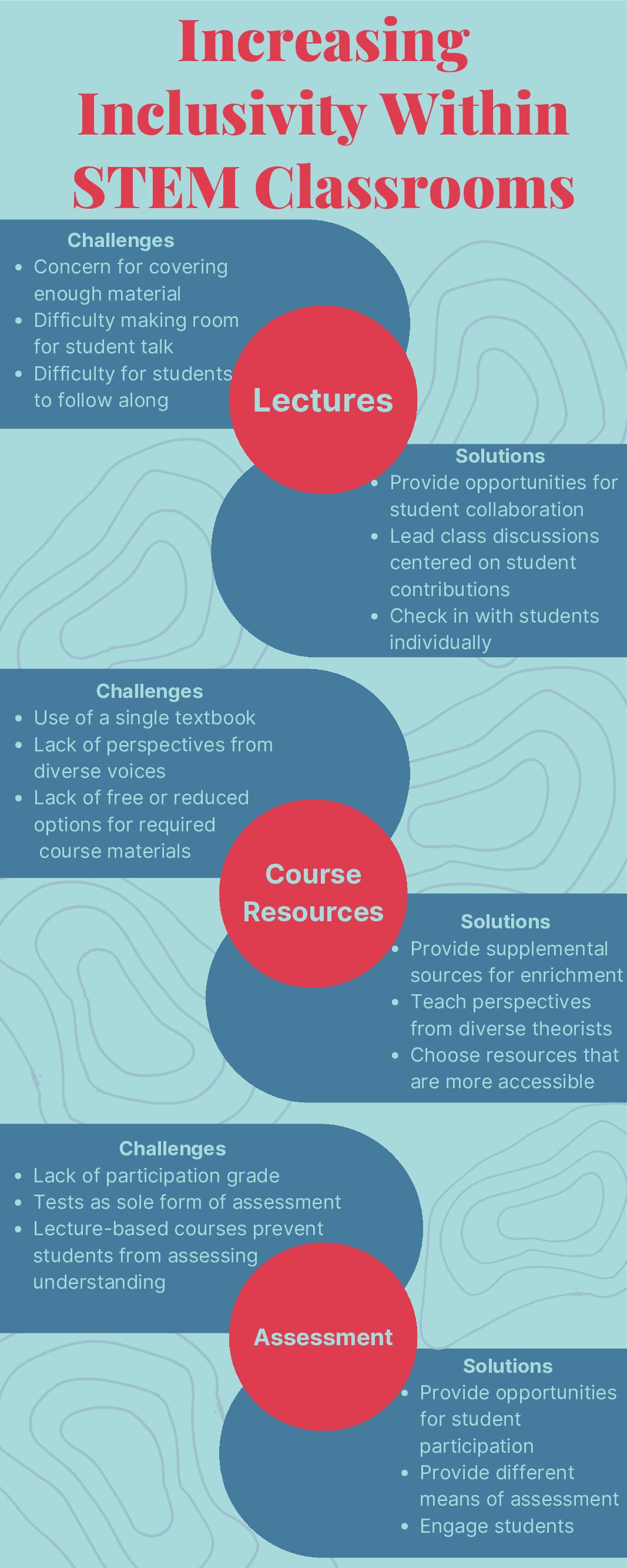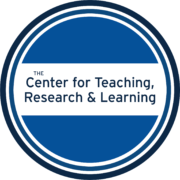Increasing Inclusivity Within STEM Classrooms
By Alli Sattler, Class of 2025
Published Spring 2023
About This Project
My name is Alli Sattler, and I am a sophomore at AU majoring in mathematics and secondary education. I have been interested in pursuing education for most of my life, as I am passionate about math and helping people. However, as I have become immersed in different levels of education and courses on education, I am more aware of the inequities that persist within the field. Learning more about injustices that persist within education has led me to think critically about my own experiences with STEM courses. Specifically, I find issues relating to STEM exclusivity intriguing and relevant to my life. STEM is traditionally considered exempt from expectations that other subjects are supposed to implement and is commonly understood as a place only for facts, not culture or context. Below, I present an infographic covering challenges as well as solutions for addressing inclusivity within STEM classrooms as well as students’ personal accounts of what STEM inclusivity looks like to them. With this project, I hope to encourage professors to think critically about their current styles of teaching and consider modifying their methods to promote a more inclusive classroom.

My Personal Account as a Student in STEM Classes
Lectures
Throughout my experience at AU, I have noticed many inequities within my STEM classes. First, most of my math classes are lecture-centered with minimal opportunities for student participation. During such lectures, it comes across that professors feel a sense of stress to cover a certain amount of material in each class period. However, in the absence of opportunities for student participation, professors often fail to ensure that students are following along and understanding the material. Opportunities for student interaction and conversation not only promote student engagement with the material, but they also provide a means for instructors to assess student comprehension. It can become difficult for students to follow along and receive help when necessary if the professor unintentionally conveys the impression that the class needs to get through a certain amount of content. In general, STEM is a space that excludes creativity due to the misconception that STEM courses are solely concerned with facts. Despite the lack of group work in my STEM courses, group work has the potential to deepen students’ understanding of course content. Further, “Creativity comes from practice and hands-on experience, and from allowing students to become explorers and to connect with other explorers” (Emdin, 2021). In providing such hands-on experiences for students, students are not only given more freedom in their learning but are also given the opportunity to be creative, which is often omitted from STEM curricula.
Course Resources
Another element that I have noticed is that this semester is the first time that both of my math classes have free online textbooks. Despite my appreciation for the accessibility of these online resources, I was troubled to learn that the decision to assign them was coincidental rather than intentional on the part of the professor. Most STEM classes require copies of dense, expensive textbooks, which creates an issue of equity and accessibility. If instructors make a conscious effort to find resources that are either free or reduced in price, STEM classes can become more accessible for all students. Another consideration on the subject of course materials is that STEM courses generally use a single textbook, rather than multiple sources like humanities courses. In doing so, STEM classes often only teach predominantly white, male theorists’ findings rather than shedding light on diverse perspectives and discoveries. In accepting the idea that “you can’t be what you can’t see,” it is important to elevate the voices of minoritized scholars to ensure that students can see themselves represented in their field. Further, this lack of representation promotes deficit thinking, which can result in trauma for minoritized students.
Assessment
A final observation is that assessments in STEM classes generally take the form of tests, in contrast to humanities courses which often include participation grades. In doing so, tests are frequently the main and often only contributor to one’s grade. This course structure may become overwhelming, as well as inequitable, for students who are weaker test-takers. Likewise, the emphasis on lectures within STEM courses fails to provide an opportunity for students to gauge their own understanding. With such concerns, it may be more effective to implement various means of assessment. Whether it be informally assessing students’ in-class participation or engaging students in class work, students’ diverse needs are more likely to be met.
Students’ Personal Accounts of STEM In/Exclusivity
To incorporate more perspectives on the issue of STEM exclusivity, I interviewed a few of my peers who are majoring in STEM subjects. Those I interviewed expressed the concern, similar to my own, that STEM classes are predominantly lecture-based. My peers lamented that, while students may ask questions in class, it can be challenging for neurodivergent students – and students in general post-Covid – to pay attention due to the preponderance of lectures. In the paragraphs that follow, I provide suggestions for how instructors can increase inclusivity within STEM classrooms.
Create a classroom environment that promotes, rather than discourages, question-asking and risk-taking.
STEM professors also generally hold exceedingly high expectations for their students, which leads students to develop a fear of being perceived as unintelligent and may inhibit them from asking questions during class. Not creating opportunities for students to ask questions or failing to create an environment in which students feel comfortable asking questions, makes it more likely that students will fall behind. In reaction to these concerns, interviewees expressed a desire for more opportunities for discussion in class, as well as for example problems throughout lectures.
Assess the level of understanding students come to the course with.
In addition to offering opportunities for collaboration in class, instructors must gauge students’ understanding while completing cooperative activities. If students do not have sufficient knowledge of the topic they are expected to figure out on their own, the practice problems will not be effective. Further, it is possible for all students to be at different levels of understanding, which can leave some students at a disadvantage. Thus, it becomes clear that to implement effective group work, professors must accurately gauge the performance and understanding of their students as well as how their students work together.
Consider independent work students may be required to complete to properly understand the expected material.
Another issue that arises from the fast-paced nature of STEM classes is that students are often required to learn material on their own. One of my interviewees relayed that one of her professors required students to watch lectures as part of their weekly homework. Although this strategy may seem efficient in getting through a certain amount of material, students are likely to encounter challenges while learning material independently. Many of the interviewees expressed feeling as though they had to teach themselves the material, even needing to go out of their way to find supplemental material on their own. In addition, some professors are more reliant than others on textbooks, which makes it difficult for some students to fully grasp the material, as most students need someone, such as the professor, to explain steps rather than simply reading through the steps as explained in the textbook. When professors take the time to explain concepts rather than having students learn them on their own, students are more likely to understand the material.
Consider free or low-cost course resources to increase access and equity.
In terms of course resources, a key theme amongst the interviewees concerned the abundance of fees each semester. In math courses, it tends to be challenging to find free online sources, but it is also inequitable to expect students to spend hundreds of dollars on a textbook that they will only be using for a few months. Likewise, many science courses require payment for access to textbooks as well as homework. The costs associated with these resources raise the issue of equity, as students are expected to pay for these materials in addition to other school fees, such as tuition. My interviewees also expressed that some instructors are assigning textbooks without considering the impact on students. One interviewee explained how her professor was visibly shocked to hear about the exorbitant price of the required text. By taking time to investigate alternative course resource options, including those that are free or reduced in price, instructors can ensure that their course materials are more equitable and accessible for students.
Use a variety of assessments beyond traditional exams.
In terms of assessment, each of the interviewees agreed that learning in STEM classes tends to be assessed by tests. “Learning has been reduced to cramming for tests, and in this type of system, students are reduced to containers that hold knowledge, instead of creators of it” (Emdin, 2021). By centering such courses around exams, students are studying for the test rather than effectively ingraining information for long-term retrieval. Further, each of the STEM majors I interviewed expressed that tests make up anywhere from 50-75% of a student’s grade. Being so test-focused, STEM courses become increasingly exclusive, as students who do not test well or do not perform well under pressure will likely fail. Since some students are better test-takers than others, it can become overwhelming taking multiple courses each with multiple exams, often overlapping with one another. In addition, STEM majors being overwhelmed with exams can lead to inconsistent test performance, as it is natural for a student to focus on one exam more than another. In doing so, STEM majors are constantly taking exams, which perpetuates the rhetoric that STEM majors’ midterm season never ends. Thus, it is highly recommended for instructors to incorporate more opportunities for assessment as well as assessment opportunities in lower-stress environments into their courses.
Integrate opportunities for participation in class and consider including participation as part of the course grade to reward the process of learning.
(See also, CTRL’s resource on Promoting and Assessing Student Participation).
On a final note, interviewees did not share my concern for the lack of participation grades present in most STEM courses. Participation is not expected in such courses unless a student has a question, which can disincentivize some students from attending class. Without the expectation of student participation, as well as minimal homework assignments, exams become the main contributors to a student’s grade. By incorporating a participation grade within STEM courses, students would have more opportunities to participate as well as to cushion their grade. To promote student participation, it is important for professors to make time throughout the semester to develop a safe classroom climate where students feel comfortable participating. A final point brought forth by an interviewee concerned the lack of extra credit opportunities in STEM courses. As STEM courses place such a heavy emphasis on exams, finding room to add a grade buffer becomes increasingly important to students and would help reduce test anxiety.
Final Thoughts
In interviewing my STEM peers, I was able to both validate my experiences within the classroom at AU as well as bring different perspectives to the issue of STEM equity and inclusivity. With this validation, the urgency of this issue became increasingly clear to me, as the intense nature of STEM results in the exclusion of various communities. To promote an inclusive atmosphere within STEM, professors should consider adapting their approaches, whether it be through increasing student voices in class, incorporating more equitable course resources, or multiple means of assessment. In doing so, STEM can not only become more inclusive but can encourage unique perspectives to join the field.
References
Emdin, C. (2021). Stem, steam, make, dream: Reimagining the culture of science technology, engineering, and mathematics. International Center for Leadership in Education.

